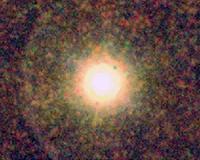 |
Paris, France (SPX) Sep 02, 2010 The galaxy NGC 4666 takes pride of place at the centre of this new image, made in visible light with the Wide Field Imager on the MPG/ESO 2.2-metre telescope at the La Silla Observatory in Chile. NGC 4666 is a remarkable galaxy with very vigorous star formation and an unusual "superwind" of out-flowing gas. It had previously been observed in X-rays by the ESA XMM-Newton space telescope, and the image presented here was taken to allow further study of other objects detected in the earlier X-ray observations. The prominent galaxy NGC 4666 in the centre of the picture is a starburst galaxy, about 80 million light-years from Earth, in which particularly intense star formation is taking place. The starburst is thought to be caused by gravitational interactions between NGC 4666 and its neighbouring galaxies, including NGC 4668, visible to the lower left. These interactions often spark vigorous star-formation in the galaxies involved. A combination of supernova explosions and strong winds from massive stars in the starburst region drives a vast flow of gas from the galaxy into space - a so-called "superwind". The superwind is huge in scale, coming from the bright central region of the galaxy and extending for tens of thousands of light-years. As the superwind gas is very hot it emits radiation mostly as X-rays and in the radio part of the spectrum and cannot be seen in visible light images such as the one presented here. This image was made as part of a follow-up to observations made with the ESA XMM-Newton space telescope in X-rays. NGC 4666 was the target of the original XMM-Newton observations, but thanks to the telescope's wide field-of-view many other X-ray sources were also seen in the background. One such serendipitous detection is a faint galaxy cluster seen close to the bottom edge of the image, right of centre. This cluster is much further away from us than NGC 4666, at a distance of about three billion light-years. In order to fully understand the nature of astronomical objects, researchers must study them at several wavelengths. This is because light of different wavelengths can tell us about different physical processes taking place. In this case the Wide Field Imager (WFI) observations were made in visible light to further investigate these serendipitously detected X-ray objects - a good example of how astronomers using different telescopes work together to explore the Universe.
Share This Article With Planet Earth
Related Links the missing link Stellar Chemistry, The Universe And All Within It
 Herschel Finds Water In Cosmic Desert
Herschel Finds Water In Cosmic DesertPasadena CA (JPL) Sep 02, 2010 The Herschel infrared space observatory has discovered that ultraviolet starlight is the key ingredient for making water in space. It is the only explanation for why a dying star is surrounded by a gigantic cloud of hot water vapor. Herschel is a European Space Agency mission with important participation from NASA. Every recipe needs a secret ingredient. When astronomers discovered an unex ... read more |
|
| The content herein, unless otherwise known to be public domain, are Copyright 1995-2010 - SpaceDaily. AFP and UPI Wire Stories are copyright Agence France-Presse and United Press International. ESA Portal Reports are copyright European Space Agency. All NASA sourced material is public domain. Additional copyrights may apply in whole or part to other bona fide parties. Advertising does not imply endorsement,agreement or approval of any opinions, statements or information provided by SpaceDaily on any Web page published or hosted by SpaceDaily. Privacy Statement |